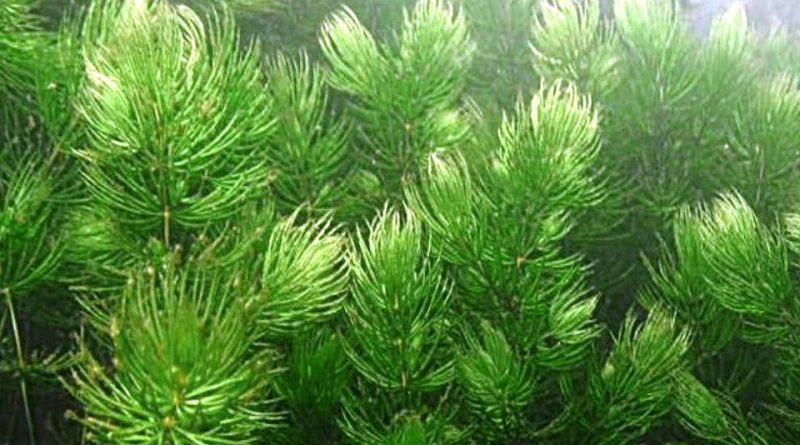Ceratophyllum demersum
Ceratophyllum demersum
The Hornwort, rigid hornwort, coontail or coon’s tail (Ceratophyllum demersum L., 1753) is an aquatic plant belonging to the Ceratophyllaceae family.
Systematics –
From a systematic point of view it belongs to:
Eukaryota Domain,
Kingdom Plantae,
Magnoliophyta Division,
Magnoliopsida class,
Subclass Magnoliidae,
Order Nymphaeales,
Ceratophyllaceae family,
Genus Ceratophyllum,
C. demersum species.
The terms are synonymous:
– Ceratophyllum aquaticum H.C. Watson;
– Ceratophyllum asperum Lam .;
– Ceratophyllum cornutum Rich .;
– Ceratophyllum gibbum Laforet ex Nyman;
– Ceratophyllum indicum Willd. ex Cham .;
– Ceratophyllum oxyacanthum Cham .;
– Ceratophyllum tricorne Dumort .;
– Ceratophyllum tricuspidatum Dumort .;
– Ceratophyllum tuberculatum Cham .;
– Ceratophyllum verticillatum Roxb .;
– Ceratophyllum vulgare Schleid .;
– Dichotophyllum demersum (L.) Moench.
Etymology –
The term Ceratophyllum comes from the Greek κέρας, -ατοϛ céras, -atos corna and φύλλον phýllon leaf: with horny leaves.
The specific epithet demersum comes from demergo immerse, sink: submerged.
Geographic Distribution and Habitat –
The Hornwort is a plant native to North America that has become cosmopolitan, prevalent in temperate and tropical regions.
Its range extends from the Azores and Europe, through the Middle East and the Indian subcontinent, to Southeast Asia and China; it is also present in Africa, north and south of the Sahara, Madagascar, Australasia and throughout the American continent.
Its habitat is mainly that of motionless or slightly moved waters, in ponds or marshes with a summer temperature of 15-30 ° C and a very rich nourishing status.
Description –
Ceratophyllum demersum is a submerged aquatic herbaceous plant that grows in filaments that can reach 1–3 meters in length.
It has numerous soft needles that increase its volume. The leaves are grouped in six or twelve with a single length ranging from 8 to 40 mm in length, and can be simple or bifurcated.
The flowers are small with a maximum size of 2 mm in length and are hardly noticeable as their petals have a green color like the rest of the plant, and then become slightly darker.
The fruit is a small nut 4–5 mm long, usually with three spines, two basal and one apical, for a total of 1–12 mm in length.
Cultivation –
Ceratophyllum demersum is a plant that prefers sandy soil rich in decaying organic matter in full sun, but tolerates shade better than most submerged aquatic plants.
This plant plays a good role as an oxygenator for ponds; it usually grows submerged in water but is sometimes found floating on the surface.
This species belongs to one of only two known dicotyledonous genera in which pollination occurs underwater. The anthers of the male flowers detach from the plant and float to the surface where they release their pollen grains. These then sink underwater to fertilize the female flowers.
However this plant reproduces more commonly agamically.
In some parts of the world, Schistosoma and malaria-carrying mosquito larvae take refuge in the leaves of plants of this genus.
Plants can also grow so vigorously that they choke streams, although they also provide good shelter for young fish.
Propagation occurs by seed which should be sown as soon as it is ripe at the beginning of autumn in a greenhouse with the pot immersed in water. Seed is likely to lose vitality quickly if allowed to dry out, so if stored it should be kept cool in a container of water and then sown in late winter.
The seedlings should be transplanted when they are large enough to be handled and planted in their permanent positions in late spring or early summer, after the last expected frosts.
Cuttings in the growing season root easily.
In nature, plants propagate when young scaly shoots or winter buds separate from the main plant.
Customs and Traditions –
This plant is often used to oxygenate aquariums and tanks with medium or tropical temperatures. Its structure also allows it to easily live with the presence of fish which, especially in the first months of life, find refuge in these plants, which are also a valid shelter against the winter cold.
From an ecological point of view, the presence of fish guarantees the production of those substances, especially nitrogen compounds, which the plant needs to grow.
It also has allelopathic qualities as it expels substances that inhibit the growth of phytoplankton and cyanobacteria (blue-green algae). Its dense growth can outgrow native underwater vegetation, leading to biodiversity loss. In New Zealand, it caused problems with hydroelectric power plants.
It is an excellent submerged plant for ponds and bio-pools and for constructed wetlands, although it can become competitive with other plants.
Preparation Method –
Ceratophyllum demersum is a pint that is mainly used as an ornamental plant in bio-pools and ponds, as well as in constructed wetlands.
Guido Bissanti
Sources
– Acta Plantarum – Flora of the Italian Regions.
– Wikipedia, the free encyclopedia.
– Useful Tropical Plants Database.
– Conti F., Abbate G., Alessandrini A., Blasi C. (ed.), 2005. An annotated checklist of the Italian vascular flora, Palombi Editore.
– Pignatti S., 1982. Flora of Italy, Edagricole, Bologna.
– Treben M., 2000. Health from the Lord’s Pharmacy, Advice and experiences with medicinal herbs, Ennsthaler Editore.
Warning: Pharmaceutical applications and alimurgical uses are indicated for informational purposes only, they do not represent in any way a medical prescription; therefore no responsibility is taken for their use for curative, aesthetic or food purposes.


